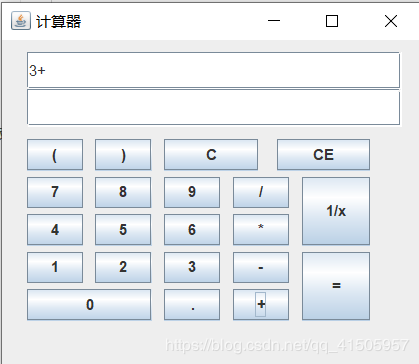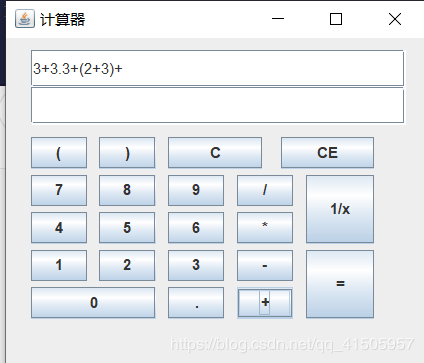java图形化界面实现简单混合运算计算器的示例代码
写了好几天了终于写完了这个四则运算计算器,总代码放在后面
截图如下:

首先是布局都比较简单,最上面的一个框是总的输出框,
第二个框是每次输入的数字显示在框内,
对于每一个按钮都增加监听器,
对于数字按钮:当长度大于8的 或者等号已经出现之后就不再处理按钮事件
if(e.getSource().equals(button1)) {
s=numberText.getText();
//数字长度大于8或者等号已出现
if(s.length()>8 || equalbook == 1) {
}
else if(s.equals("0") || s.equals("")) {
numberText.setText("1");
}else {
numberText.setText(s + "1");
}
}
其余的按钮都差不多。
当按钮为小数点时,长度大于7就不再处理,因为总的长度不能超过8,而小数点后面还要与数字,
同时标记小数点已经出现过,因为一个数中最多出现一个小数点
//当按钮为小数点时
if(e.getSource().equals(buttonpoint)) {
s=numberText.getText();
if(s.length()>7 || equalbook == 1) {
}
if(pointbook==0) {
numberText.setText(s + ".");
pointbook = 1;
}
}
当按钮为加号时:
当数字输入框为空时不做处理

也有可能是最后一位是小数点,当然也不处理

当最上方的输出框的最后一位是右括号的时候,可以用加号

//当按钮为加号时
if(e.getSource().equals(buttonadd)) {
s=numberText.getText();
char ch1[] = s.toCharArray();
int length1 = s.length() - 1;
String S = expressText.getText();
char ch2[] = S.toCharArray();
int length2 = S.length() - 1;
//当数字为空或为0或数字的最后一位是小数点时不作处理
if((length2 == -1 ||ch2[length2] != ')') && (s.equals("0") || s.equals("") || ch1[length1] == '.')) {
}else {
numberText.setText("");
expressText.setText(expressText.getText() + s + "+");
}
}
+, -, *, /都差不多
当前面是运算符或者左括号的时候才能用左括号, 注意当框内无元素的时候也可以加左括号, 但是需要判断元素的个数是否大于0
if(e.getSource().equals(buttonleft)) {
if(!numberText.getText().equals("0") && !numberText.getText().contentEquals("")) {
expressText.setText(expressText.getText() + numberText.getText());
}
s=expressText.getText();
char ch[] = s.toCharArray();
int length = s.length() - 1;
/*
* 当前面是运算符或者左括号的时候才能用左括号
* 注意当框内无元素的时候也可以加左括号
* 但是需要判断元素的个数是否大于0
*/
if(length == -1 || ch[length] == '+' || ch[length] == '-' ||
ch[length] == '*' || ch[length] == '/' ||
ch[length] == '(' || s.equals("")) {
expressText.setText(expressText.getText() + '(');
leftNum++;
}
}
右括号就不一样
if(e.getSource().equals(buttonright)) {
if(!numberText.getText().equals("0")) {
expressText.setText(expressText.getText() + numberText.getText());
numberText.setText("");
}
s=expressText.getText();
char ch[] = s.toCharArray();
int length = s.length() - 1;
/*
* 只有前面是数字的时候且左括
* 号的数量大于右括号的数量的时候才能加右括号
*/
if(Character.isDigit(ch[length]) && leftNum > rightNum) {
rightNum++;
expressText.setText(expressText.getText() + ')');
}
}
当按钮为 C时,清除所有内容并更新等号状态, 左括号数量, 右括号数量, 小数点状态,当一次计算完成之后,只有按C按钮才能进行新的计算。
当按钮为CE时,只清除数字框中的内容。
if(e.getSource().equals(buttonC)) {
numberText.setText("0");
expressText.setText("");
leftNum = 0;
rightNum = 0;
pointbook = 0;
equalbook = 0;
}
当按钮为等号时就把总输出框中显示的字符串取出进行计算,因为这个计算器是带括号的,所以这里我用了逆波兰表达式做的,需要把中缀表达式变为后缀表达式,然后进行计算,这一点我认为是最困难的一点,后面有时间我会再写关于 逆波兰表达式实现以及 逆波兰表达式的求值。
需要注意588行的代码,最后的两个括号的条件没有加上,导致花了周末一天在找bug......
else if((ch[j] == '*' || ch[j] == '/') &&
(operater1=='+' || operater1=='-') ||
(operater1=='(' || operater1 == ')')) {
Operater.push(ch[j]);
break;
}
所有代码:
package cn.edu.shengda;
/*
* author 201705050153 张宜强
*/
import java.awt.Color;
import java.awt.event.ActionEvent;
import java.awt.event.ActionListener;
import java.util.Stack;
import javax.swing.JButton;
import javax.swing.JFrame;
import javax.swing.JTextField;
public class Calculator extends JFrame implements ActionListener {
Calculator() {
init();
}
public void init() {
JFrame frame = new JFrame ("计算器");
frame.setBackground(Color.yellow);
frame.setLayout(null);
//放置数字0
button0 = new JButton("0");
button0.setBounds(20, 200, 100, 25);
frame.add(button0);
//放置数字1
button1 = new JButton("1");
button1.setBounds(20, 170, 45, 25);
frame.add(button1);
//放置数字2
button2 = new JButton("2");
button2.setBounds(75, 170, 45, 25);
frame.add(button2);
//放置数字3
button3 = new JButton("3");
button3.setBounds(130, 170, 45, 25);
frame.add(button3);
//放置数字4
button4 = new JButton("4");
button4.setBounds(20, 140, 45, 25);
frame.add(button4);
//放置数字5
button5 = new JButton("5");
button5.setBounds(75, 140, 45, 25);
frame.add(button5);
//放置数字6
button6 = new JButton("6");
button6.setBounds(130, 140, 45, 25);
frame.add(button6);
//放置数字7
button7 = new JButton("7");
button7.setBounds(20, 110, 45, 25);
frame.add(button7);
//放置数字8
button8 = new JButton("8");
button8.setBounds(75, 110, 45, 25);
frame.add(button8);
//放置数字9
button9 = new JButton("9");
button9.setBounds(130, 110, 45, 25);
frame.add(button9);
//放置 .
buttonpoint = new JButton(".");
buttonpoint.setBounds(130, 200, 45, 25);
frame.add(buttonpoint);
//放置 +
buttonadd = new JButton("+");
buttonadd.setBounds(185, 200, 45, 25);
frame.add(buttonadd);
//放置 -
buttonreduce = new JButton("-");
buttonreduce.setBounds(185, 170, 45, 25);
frame.add(buttonreduce);
//放置 *
buttonride = new JButton("*");
buttonride.setBounds(185, 140, 45, 25);
frame.add(buttonride);
//放置 /
buttonexcept = new JButton("/");
buttonexcept.setBounds(185, 110, 45, 25);
frame.add(buttonexcept);
//放置 =
buttonequal = new JButton("=");
buttonequal.setBounds(240, 170, 55, 55);
frame.add(buttonequal);
//计算1/x
buttoninvert = new JButton("1/x");
buttoninvert.setBounds(240, 110, 55, 55);
frame.add(buttoninvert);
//放置左括号
buttonleft = new JButton("(");
buttonleft.setBounds(20, 80, 45, 25);
frame.add(buttonleft);
//放置右括号
buttonright = new JButton(")");
buttonright.setBounds(75, 80, 45, 25);
frame.add(buttonright);
//放置C 消除所有输入
buttonC = new JButton("C");
buttonC.setBounds(130, 80, 75, 25);
frame.add(buttonC);
//放置CE 消除当前输入
buttonCE = new JButton("CE");
buttonCE.setBounds(220, 80, 75, 25);
frame.add(buttonCE);
//添加表达式文本框
expressText = new JTextField();
expressText.setBounds(20, 10, 300, 30);
frame.add(expressText);
//添加数字文本框
numberText = new JTextField("0");
numberText.setBounds(20, 40, 300, 30);
frame.add(numberText);
//加监听器
button0.addActionListener(this);
button1.addActionListener(this);
button2.addActionListener(this);
button3.addActionListener(this);
button4.addActionListener(this);
button5.addActionListener(this);
button6.addActionListener(this);
button7.addActionListener(this);
button8.addActionListener(this);
button9.addActionListener(this);
buttonpoint.addActionListener(this);
buttonadd.addActionListener(this);
buttonreduce.addActionListener(this);
buttonride.addActionListener(this);
buttonexcept.addActionListener(this);
buttoninvert.addActionListener(this);
buttonequal.addActionListener(this);
buttonleft.addActionListener(this);
buttonright.addActionListener(this);
buttonC.addActionListener(this);
buttonCE.addActionListener(this);
numberText.addActionListener(this);
expressText.addActionListener(this);
frame.setBounds(0, 0, 350, 300);
frame.setDefaultCloseOperation(JFrame.EXIT_ON_CLOSE);
frame.setVisible(true);
}
JButton button0;
JButton button1;
JButton button2;
JButton button3;
JButton button4;
JButton button5;
JButton button6;
JButton button7;
JButton button8;
JButton button9;
JButton buttonpoint;
JButton buttonadd;
JButton buttonreduce;
JButton buttonride;
JButton buttonexcept;
JButton buttonequal;
JButton buttoninvert;
JButton buttonleft;
JButton buttonright;
JButton buttonC;
JButton buttonCE;
JTextField numberText;
JTextField expressText;
String s = null;
//记录小数点是否出现,每次当前数字框中只能出现一个小数点
int pointbook = 0;
//记录等号是否出现,每次计算的总算式只能出现一个等号
int equalbook = 0;
//记录左括号的数量
int leftNum = 0;
//记录有括号的数量
int rightNum = 0;
@Override
public void actionPerformed(ActionEvent e) {
// TODO Auto-generated method stub
//当按钮为0时
if(e.getSource().equals(button0)) {
s=numberText.getText();
if(s.length()>8) {
}
else if(s.equals("0") || equalbook == 1) {
}else {
numberText.setText(s + "0");
}
}
//当按钮为1时
if(e.getSource().equals(button1)) {
s=numberText.getText();
if(s.length()>8 || equalbook == 1) {
}
else if(s.equals("0") || s.equals("")) {
numberText.setText("1");
}else {
numberText.setText(s + "1");
}
}
//当按钮为2时
if(e.getSource().equals(button2)) {
s=numberText.getText();
if(s.length()>8 || equalbook == 1) {
}
else if(s.equals("0") || s.equals("")) {
numberText.setText("2");
}else {
numberText.setText(s + "2");
}
}
//当按钮为3时
if(e.getSource().equals(button3)) {
s=numberText.getText();
if(s.length()>8 || equalbook == 1) {
}
else if(s.equals("0") || s.equals("")) {
numberText.setText("3");
}else {
numberText.setText(s + "3");
}
}
//当按钮为4时
if(e.getSource().equals(button4)) {
s=numberText.getText();
if(s.length()>8 || equalbook == 1) {
}
else if(s.equals("0") || s.equals("")) {
numberText.setText("4");
}else {
numberText.setText(s + "4");
}
}
//当按钮为5时
if(e.getSource().equals(button5)) {
s=numberText.getText();
if(s.length()>8 || equalbook == 1) {
}
else if(s.equals("0") || s.equals("")) {
numberText.setText("5");
}else {
numberText.setText(s + "5");
}
}
//当按钮为6时
if(e.getSource().equals(button6)) {
s=numberText.getText();
if(s.length()>8 || equalbook == 1) {
}
else if(s.equals("0") || s.equals("")) {
numberText.setText("6");
}else {
numberText.setText(s + "6");
}
}
//当按钮为7时
if(e.getSource().equals(button7)) {
s=numberText.getText();
if(s.length()>8 || equalbook == 1) {
}
else if(s.equals("0") || s.equals("")) {
numberText.setText("7");
}else {
numberText.setText(s + "7");
}
}
//当按钮为3时
if(e.getSource().equals(button8)) {
s=numberText.getText();
if(s.length()>8 || equalbook == 1) {
}
else if(s.equals("0") || s.equals("")) {
numberText.setText("8");
}else {
numberText.setText(s + "8");
}
}
//当按钮为9时
if(e.getSource().equals(button9)) {
s=numberText.getText();
if(s.length()>8 || equalbook == 1) {
}
else if(s.equals("0") || s.equals("")) {
numberText.setText("9");
}else {
numberText.setText(s + "9");
}
}
//当按钮为小数点时
if(e.getSource().equals(buttonpoint)) {
s=numberText.getText();
if(s.length()>7 || equalbook == 1) {
}
if(pointbook==0) {
numberText.setText(s + ".");
pointbook = 1;
}
}
//当按钮为加号时
if(e.getSource().equals(buttonadd)) {
s=numberText.getText();
char ch1[] = s.toCharArray();
int length1 = s.length() - 1;
String S = expressText.getText();
char ch2[] = S.toCharArray();
int length2 = S.length() - 1;
//当数字为空或为0或数字的最后一位是小数点时不作处理
if((length2 == -1 ||ch2[length2] != ')') && (s.equals("0") || s.equals("") || ch1[length1] == '.')) {
}else {
numberText.setText("");
expressText.setText(expressText.getText() + s + "+");
}
}
//当按钮为减号时
if(e.getSource().equals(buttonreduce)) {
s=numberText.getText();
char ch1[] = s.toCharArray();
int length1 = s.length() - 1;
String S = expressText.getText();
char ch2[] = S.toCharArray();
int length2 = S.length() - 1;
if((length2 == -1 ||ch2[length2] != ')') && (s.equals("0") || s.equals("") || ch1[length1]=='.')) {
}else {
numberText.setText("");
expressText.setText(expressText.getText() + s + "-");
}
}
//当按钮为乘号时
if(e.getSource().equals(buttonride)) {
s=numberText.getText();
char ch1[] = s.toCharArray();
int length1 = s.length() - 1;
String S = expressText.getText();
char ch2[] = S.toCharArray();
int length2 = S.length() - 1;
if((length2 == -1 ||ch2[length2] != ')') && (s.equals("0") || s.equals("") || ch1[length1]=='.')) {
}else {
numberText.setText("");
expressText.setText(expressText.getText() + s + "*");
}
}
//当按钮为除号时
if(e.getSource().equals(buttonexcept)) {
s=numberText.getText();
char ch1[] = s.toCharArray();
int length1 = s.length() - 1;
String S = expressText.getText();
char ch2[] = S.toCharArray();
int length2 = S.length() - 1;
if((length2 == -1 ||ch2[length2] != ')') && (s.equals("0") || s.equals("") || ch1[length1]=='.')) {
}else {
numberText.setText("");
expressText.setText(expressText.getText() + s + "/");
}
}
//当按钮为左括号时
if(e.getSource().equals(buttonleft)) {
if(!numberText.getText().equals("0") && !numberText.getText().contentEquals("")) {
expressText.setText(expressText.getText() + numberText.getText());
}
s=expressText.getText();
char ch[] = s.toCharArray();
int length = s.length() - 1;
/*
* 当前面是运算符或者左括号的时候才能用左括号
* 注意当框内无元素的时候也可以加左括号
* 但是需要判断元素的个数是否大于0
*/
if(length == -1 || ch[length] == '+' || ch[length] == '-' ||
ch[length] == '*' || ch[length] == '/' ||
ch[length] == '(' || s.equals("")) {
expressText.setText(expressText.getText() + '(');
leftNum++;
}
}
//当按钮为右括号时
if(e.getSource().equals(buttonright)) {
if(!numberText.getText().equals("0")) {
expressText.setText(expressText.getText() + numberText.getText());
numberText.setText("");
}
s=expressText.getText();
char ch[] = s.toCharArray();
int length = s.length() - 1;
/*
* 只有前面是数字的时候且左括
* 号的数量大于右括号的数量的时候才能加右括号
*/
if(Character.isDigit(ch[length]) && leftNum > rightNum) {
rightNum++;
expressText.setText(expressText.getText() + ')');
}
}
/*
*当按钮为 C时
*清除所有内容
*并更新等号状态, 左括号数量, 右括号数量, 小数点状态
*当一次计算完成之后,只有按CE按钮才能进行新的计算
*/
if(e.getSource().equals(buttonC)) {
numberText.setText("0");
expressText.setText("");
leftNum = 0;
rightNum = 0;
pointbook = 0;
equalbook = 0;
}
/*
*当按钮为CE时,
*清除当前数字框中内容
*更新小数点状态
*/
if(e.getSource().equals(buttonCE)) {
numberText.setText("0");
pointbook = 0;
}
//当按钮为1/x时把输入框中的值变为倒数
if(e.getSource().equals(buttoninvert) ) {
s = numberText.getText();
//等于0的时候不进行操作
if(s.equals("0")) {
}else {
double a = Double.parseDouble(numberText.getText());
a = 1/a;
numberText.setText(String.valueOf(a));
}
}
//当按钮为等于号时
if(e.getSource().equals(buttonequal)) {
s=numberText.getText();
if(!s.equals("0") && !s.equals("")) {
expressText.setText(expressText.getText() + s);
}
//当等号没有出现时才能输入等号
if(equalbook == 0) {
numberText.setText("");
//补全右括号
for(int i = 0; i < leftNum - rightNum; i++) {
expressText.setText(expressText.getText() + ')');
}
/*
* 声明栈
* 一个char型存储运算符
* 将中缀表达式转化为逆波兰表达式
*/
String[] ansString = new String[100];
int Size = 0;
Stack<Character> Operater = new Stack<Character>();
s = expressText.getText();
char ch[] = s.toCharArray();
int length = ch.length;
for(int j = 0; j < length; j++) {
//当数组元素为数字时
if(ch[j] >='0' && ch[j] <= '9') {
double Number = ch[j] - '0';
//继续往后遍历,直到不是数字和小数点
//记录小数点是否出现
int point = 0;
//记录小数点出现后的位数
int bit = 1;
if(j==length-1) {
ansString[Size++] = String.valueOf(Number);
}
for(j++; j<length; j++) {
if((ch[j] < '0' || ch[j] >'9') && ch[j]!='.') {
j--;
ansString[Size++] = String.valueOf(Number);
break;
}
if(ch[j] == '.') {
point = 1;
continue;
}
if(ch[j] >= '0' && ch[j] <= '9') {
/*
* 当小数点没有出现时和没出现时要分开讨论
*/
if(point == 0) {
Number = Number * 10 + (ch[j] - '0');
} else {
Number = Number + Math.pow(10, -bit) * (ch[j]-'0');
bit++;
}
}
}
} else { //考虑运算符
if(ch[j] =='(') {
Operater.push('(');
} else if(ch[j]==')') {
while(!Operater.peek().equals('(')) {
ansString[Size++] = String.valueOf(Operater.peek());
Operater.pop();
}
Operater.pop();
} else {
if(Operater.empty()) {
Operater.push(ch[j]);
}
else {
//System.out.println("!" + ch[j]);
while(true) {
if(Operater.empty()) {
Operater.push(ch[j]);
break;
}
char operater1 = Operater.peek();
if((ch[j] == '*' || ch[j] == '/') &&
(operater1=='+' || operater1=='-') || (operater1=='(' || operater1 == ')')) {
Operater.push(ch[j]);
break;
}
else {
ansString[Size++] = String.valueOf(Operater.peek());
Operater.pop();
}
}
}
}
}
}//System.out.println(s);
while(!Operater.empty()) {
ansString[Size++] = String.valueOf(Operater.peek());
Operater.pop();
}
// for(int i=0; i<Size; i++)
// System.out.println(ansString[i]);
//最后计算逆波兰表达式的值
Stack<Double> Last = new Stack<Double>();
for(int i=0; i<Size; i++) {
String s1 = ansString[i];
char ch2[] = s1.toCharArray();
if(ch2[0]>='0' && ch2[0]<='9') {
Last.push(Double.parseDouble(s1));
}
else {
double num1 = Last.pop();
double num2 = Last.pop();
double num3 = 0;
if(ch2[0]=='+')
num3 = num2 + num1;
else if(ch2[0]=='-')
num3 = num2 - num1;
else if(ch2[0]=='*')
num3 = num2 * num1;
else if(ch2[0]=='/')
num3 = num2 / num1;
Last.push(num3);
}
}
expressText.setText(expressText.getText() + "=" + Last.pop());
equalbook = 1;
}
}
}
public static void main(String []args) {
Calculator calculator = new Calculator();
}
}
以上就是本文的全部内容,希望对大家的学习有所帮助,也希望大家多多支持我们。
赞 (0)

